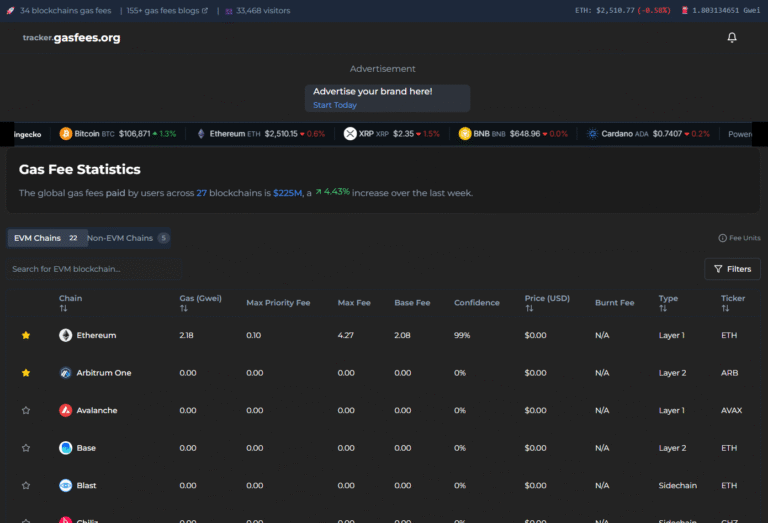
What Are Harmony Gas Fees?
Written By: Mr. GasMan
Harmony has rapidly carved a niche in the blockchain world, captivating developers and users with its lightning-fast transaction speeds and incredibly low gas fees. Unlike the infamous gas price hikes plaguing Ethereum, Harmony offers a breath of fresh air, making it a prime contender for everyday dApp usage and mass adoption.
But how exactly does Harmony achieve these phenomenal feats? What are gas fees on Harmony, and why are they so minuscule? This comprehensive guide demystifies Harmony’s gas fee structure, empowering you to navigate the network with confidence.
Harmony’s Gas Fee Mechanism: Demystifying the ONE Token
Just like gasoline fuels a car, gas fees power transactions on a blockchain. In Harmony’s case, the native ONE token serves as the fuel, paying validators for processing transactions and securing the network.
Harmony, built on a Proof-of-Stake (PoS) consensus mechanism, incentivizes validators to stake their ONE tokens. Validators verify transactions and add them to the blockchain, earning rewards in the form of newly minted ONE tokens. Users pay gas fees in ONE to incentivize validators to prioritize their transactions.
Here’s the key differentiator: Harmony’s sharded architecture plays a crucial role in keeping gas fees incredibly low. Sharding essentially splits the blockchain into smaller, parallel chains called shards, significantly increasing the network’s transaction processing capacity. Think of it as adding more lanes to a highway – transactions can be processed simultaneously on multiple shards, reducing congestion and lowering fees.
Harmony’s Gas Fee Advantage: Pennies, Not Dollars
The impact of sharding is evident in Harmony’s gas fees, which are a fraction of a cent compared to Ethereum’s often eye-watering costs. A typical transaction on Harmony costs around 0.000021 ONE, which translates to mere fractions of a dollar. Contrast this with Ethereum, where simple transactions can easily cost several dollars, and complex smart contract interactions can balloon into hundreds or even thousands.
Opens in a new windowwww.reddit.com
Ethereum Gas Tracker showing high gas fees
This dramatic difference makes Harmony significantly more appealing for everyday use cases like sending tokens, trading on decentralized exchanges (DEXs), and interacting with dApps. Developers, too, find Harmony’s low fees attractive, as it enables them to build cost-effective dApps accessible to a wider user base.
What Influences Gas Fees on Harmony?
While Harmony boasts incredibly low gas fees, it’s important to understand the factors that can influence them:
- Transaction complexity: More complex transactions involving large amounts of data or smart contract execution generally require more computational resources and incur slightly higher fees.
- Network congestion: During periods of high demand, gas fees may see temporary spikes as validators prioritize transactions with higher fees. However, due to Harmony’s efficient sharded architecture, such congestion is rare.
- Shard selection: When initiating a transaction, users can choose the shard they want it processed on. Shards with fewer transactions will generally have lower fees.
Strategies for Optimizing Gas Costs on Harmony
Despite Harmony’s inherently low fees, here are some tips for further optimizing your gas costs:
- Choose the right shard: Use tools like Harmony Block Explorer to identify shards with less activity and lower fees for your transaction.
- Schedule transactions strategically: Avoid peak network usage times, typically during the day or during major events on the platform.
- Batch transactions: When possible, group multiple transactions into one to minimize individual gas fees.
- Utilize gas fee estimation tools: Several tools and dApps on Harmony provide accurate gas fee estimates, helping you plan your transactions effectively.
Harmony Gas Fees: Fueling the Future of Scalable Blockchain
Harmony’s innovative fee structure is a cornerstone of its value proposition. By enabling fast, affordable transactions, Harmony opens up a world of possibilities for blockchain technology, potentially paving the way for mass adoption and mainstream use. Developers can build powerful dApps without exorbitant fee burdens, users can interact with the blockchain affordably, and the entire ecosystem thrives on this cost-effective foundation.
As Harmony continues to evolve and attract more users and developers, its gas fee dynamics may shift. However, the core principles of sharding, PoS, and a focus on scalability are likely to remain central to keeping Harmony’s gas fees among the lowest in the blockchain landscape.
Share this blog:









